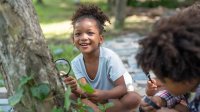Teaching Young Learners to Connect With Nature
Teachers can guide pre-K students to understand and appreciate nature by discussing and documenting their observations.
Your content has been saved!
Go to My Saved Content.When young children spend time in natural environments, their cognitive, social and emotional, and communication skills improve. Connecting with nature expands brain development, promotes social interaction, and provides an environment conducive for imaginary play, discovery, wonder, and effortless curiosity.
As educators, we want to provide the necessary avenues that young children require to develop into happy, empathetic, kind individuals. Nature is full of awe-inspiring beauty, and we simply need to take advantage of the opportunity of exposing children to its boundless experiences. Nature provokes children into action to formulate their own ideas and self-guided investigations. When children are fully immersed and exposed to experiences with nature, they’re given an open invitation for free adventure.
Getting Started
When teachers guide young children out into nature, whether it’s a large tree-filled playground, a raised garden bed, a small grassy knoll, or a tree box on the school’s sidewalk, they become “nature detectives” searching and unearthing the unknown.
As the lead detective, remind and connect students with their senses; ask them questions that relate to each of the five senses by asking open-ended questions: “What do you see?” “What do you smell?” “What do you feel?” “What do you hear?”
They may discover new sounds—a woodpecker searching for embedded bugs in tree bark, the sound of male cicadas signaling a mate, birds singing, a crow cawing, or a squirrel scampering up a tree. They might see a chipmunk darting back into the safety of its burrow, a robin running across the grass and stopping briefly to listen intently for the movement of an earthworm below the ground, a bird’s nest high in a tree, or the movement of leaves on a tree blowing in the wind. They can feel the roughness of bark on a tree, cool dirt, gritty sand, and jagged rocks.
Teachers can further deepen children’s discoveries by asking more specific questions about what they found or discovered with their senses, which will promote the next level of inquiry. For example, ask, “What can you do with these nature items?” “What do these things remind you of?” “What can these items do?” or “Where did you find these things you collected?”
Next, teachers can support student nature observations through documentation by taking photographs, recording conversations, revisiting nature environments, and bringing nature inside. Teachers can also empower their students to enhance their own nature experiences by providing them with small box cameras if their class budget allows, magnifying glasses, and shovels for digging, as well as small squares of paper and writing tools for drawing what they see.
Children can revisit familiar nature spots where they’ll discover something new; using wondering questions will often give children a new perspective on an already investigated area. For example, a teacher may ask, “Does the ground look wet or dry?” or “Does the dirt have new holes in it?” or “Did you notice shadows today?”
Creating a Nature Documentation Center
It’s important to observe where and what the children are interested in and support those interests by documenting each student’s thoughts and ideas. Educators can create a “Nature Documentation Center” in their classroom. This area doesn’t need to be complex in any way, and both teacher and students can utilize it. When nature is brought from outside to inside the classroom, both teacher and students can benefit. Creating a designated space gives students opportunities to further observe and ponder their found nature materials; it enables scenarios where students can partner and work together, and perhaps share and explain to fellow students what first drew them to collect their nature items.
Using baskets, shoeboxes, or small fabric or paper bags, students can collect appropriate nature items to transfer into the classroom. Teachers can determine within their classroom schedules if one or more days can be designated for nature collecting. Having a student-friendly area to drop off nature items can be ideal: a table, a bookshelf, lower cubby areas, designated bins, or perhaps shoeboxes with tops or cigar boxes with children’s names, which can be easily stacked in a corner. A shoe bag with student names on each pocket can give each student their own space to drop off items. These can easily be hung over a door or stuck to the wall with removable hooks.
Using fishing line or wire, hang light objects found in nature—pine cones, sticks, leaves, or flowers—on a small tree branch, either suspended from a ceiling (if permitted by licensing) or placed in a container filled with sand for stability. This method not only documents student discoveries but is a beautiful art installation.
The Nature Documentation Center will give students a sense of pride and accomplishment, a daily reminder of their personal discoveries from nature and their further quest of continuing to carefully watch and learn how nature is designed and how they play a part in preserving it.
Specific activities can center around temporary nature investigations that students do in the classroom and then dismantle and return to nature. For example, trays of dirt can be part of a science activity; students can explore the dirt with magnifying glasses or, if available, a microscope to search for microscopic animals, mold, fungi, or small particles of sand and dirt composition. Additionally, students can gently observe small living creatures—earthworms, grubs, beetles, ants—or even cicada exoskeletons. Of course, returning all living creatures back to nature further supports empathy and respect for all living things.
No matter how grand or small your ways of connecting your students to nature, the most valuable thing is to break down the barrier of thinking that nature is dangerous, scary, or unattainable to young children. Experiences with nature give children the tools they need to appreciate our Earth and hopefully to care for one another.
